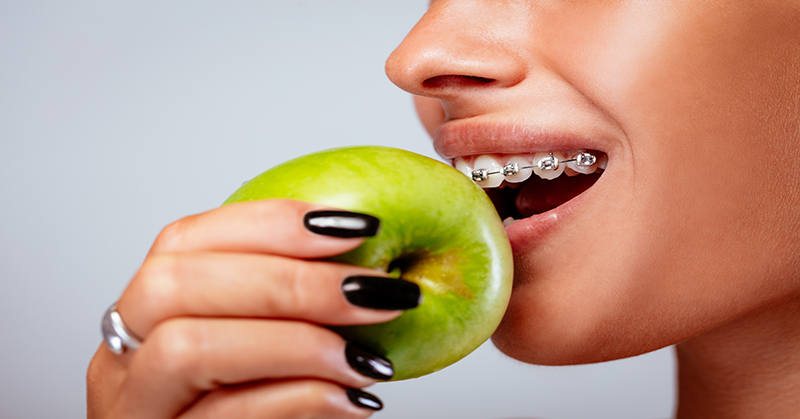Do You Know All These Different Types of Implants?
In the field of dentistry, dental implants have revolutionized the way we approach tooth replacement. With their durability, functionality, and aesthetic appeal, dental implants have become the go-to solution for individuals with missing teeth. However, not all dental implants are created equal. There are various types of dental implants, each with its own unique characteristics and applications. In this comprehensive guide, we will explore the different types of dental implants and the techniques used for their placement.Food Rules to Follow When You Wear Braces or Invisalign
updated on November 15, 2023
Orthodontic treatments like braces and Invisalign have become popular options for straightening teeth and improving oral health. While the end results are transformative, living with an orthodontic appliance requires some adjustments to your lifestyle, particularly when it comes to eating. Both braces and Invisalign trays require special care when eating and drinking to avoid damage that can extend treatment time. No matter which type of appliance you have, following key mealtime rules and modifying some eating habits is crucial for protecting your investment in that new smile.
In this article, we will provide eating guidelines and food rules to follow for both braces and Invisalign wearers. You’ll learn which foods to enjoy or avoid, when to take trays out, and how to properly care for your appliance after meals. With some simple changes to your eating regimen, you can keep your braces or aligners intact and your treatment on track for achieving the healthy, straight smile you want.
Rules for Invisalign
To get the most out of Invisalign treatment, it's essential to follow specific guidelines around eating and caring for your aligners.
Limit Tray Removal to Main Meals and Snacks
Only remove your Invisalign trays for eating during main meals and 1-2 small snacks per day. Wearing your aligners 20-22 hours daily is crucial for achieving proper teeth movement. Over-removing trays or constant snacking can greatly slow your progress. Limiting tray-free time also helps avoid side effects like bad breath.
Avoid Foods and Drinks That Can Damage Trays
When trays are out for meals, avoid extremely hot, sticky, and hard foods that could warp or stain the plastic. Foods like caramel, gum, nuts, and popcorn should be avoided. Use caution with staining foods and drinks like coffee, tea, red wine, curries, and dark sodas as these can discolor aligners over time. Moderation of staining items is advised.
Clean Teeth Thoroughly After Eating
After eating, brush and floss carefully before reinserting aligners. Any debris left behind gets trapped against your teeth, raising your risk of cavities, gingivitis and other issues. Always properly clean your teeth after meals and rinse aligners before putting them back in.
Carry a To-Go Kit When Eating Out
Have a toothbrush, floss, and case with you when eating out to easily clean up after meals. Excusing yourself to quickly brush after eating at restaurants is perfectly acceptable. A portable kit makes following the Invisalign rules more convenient.
Rules for Braces
Don’t know what to eat or avoid with braces? There are some limitations, but you can still enjoy tasty foods by following these key guidelines:
Avoid Hard, Chewy, and Sticky Foods
Hard candies, caramel, gum, and gummies can get stuck in braces and damage wires. Crunchy foods like chips, nuts, and popcorn also pose a risk for bending or dislodging brackets when chewing. Cut up hard fruits and vegetables into small pieces before eating.
Choose Softer Foods After Adjustments
After first getting braces, stick to gentle foods like mashed potatoes, eggs, yogurt, and soup until any sensitivity subsides. Avoid anything too hot, cold, crunchy, chewy, or acidic at first.
Rinse with Fluoride and Stay Hydrated
Limit sugary drinks and juice that can cause cavities around braces. Milk and fluoridated water are better choices. Be sure to brush carefully and rinse daily with fluoride mouthwash. Drinking plenty of water supports oral health.
Modify and Portion Tricky Foods
You can still enjoy pizza and popcorn with some modifications. Fold pizza slices or use a knife and fork to avoid the crust. Choose air-popped popcorn without butter for a healthier crunch. Cut fruits and veggies into bite-sized pieces.
See Your Orthodontist if Brackets Loosen
If a bracket ever feels loose, contact your orthodontist right away to have it promptly fixed. This prevents prolonged treatment time. Regular visits allow early detection of any issues.
With some adjustments like avoiding harmful foods and maintaining good hygiene, braces don’t have to limit your nutrition or enjoyment of meals. Follow these simple rules, and you’ll be smiling that beautiful new smile in no time!

free&low-cost dental clinics
View Now
dental health

Dental Implants

Dental Implants
How to get free dental implants?
When it comes to dental implants, the cost can sometimes make you clench your teeth harder than the cold does. But fear not! There are a plethora of avenues to explore for low-cost or even free dental care. From state and local resources to dental schools and community health centers, let’s dive into where you can find that much-needed dental implants without breaking the bank.
Dental Implants
Why Are Implants So Expensive?
According to recent statistics, tooth loss is a prevalent issue, especially among older individuals. Adults between the ages of 20 to 64 have an average of 25.5 remaining teeth. However, factors such as age, smoking, lower income, and education level can contribute to a higher likelihood of tooth loss. In this article, we will explore dental implants in detail through the following aspects:
Dental Implants
How Can I Get Government Grants for Dental Implants?
Dental implants are a sought-after solution for missing teeth, offering a long-term fix that can significantly improve quality of life. However, the cost of dental implants can be prohibitive for many. Understanding government programs and other grants available for dental care, particularly dental implants, can help bridge this financial gap. In this guide, we will walk you through some government assistance and grant programs aimed at making dental implants more accessible.
Dental Implants
Will Your Insurance Cover Dental Implants?
Dental implants are growing in popularity, with over 3 million Americans choosing them to replace missing teeth. While implants fuse securely into the jawbone providing natural-looking and long-lasting tooth replacements, the process does come with a hefty price tag. On average, a single implant can cost $1,600-$2,200 out of pocket. For patients needing multiple implants or other restorative work, these expenses quickly add up.
Dental Implants
How Painful is Dental Implant Surgery?
If you are missing teeth due to decay, injury, or gum disease, dental implants offer an effective and natural-looking replacement option. Unlike removable dentures that can slip, implants fuse securely into your jawbone for permanent stability. They also help preserve bone and support surrounding teeth better than bridges or dentures. But most patients wonder - how painful are implants? The procedure does involve surgery and recovery time.







